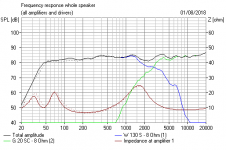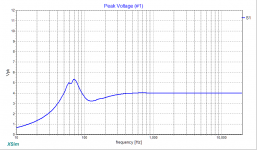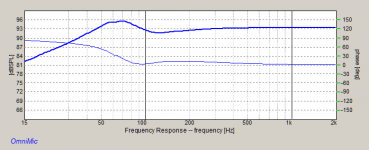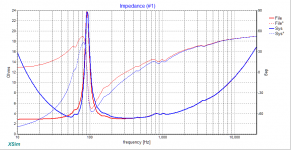I have just got a pair of Mk1 Wharfedale Diamonds to play around with. Hugely successful cheap speaker from the 1980s. One aspect of the design is a 450uF capacitor in series with the main drive unit (which runs full range) (The speaker is rated at 6ohm)
My understanding is that the reason for this is so that a smaller cabinet can be used, and the cap brings down the resonant peak. I believe KEF used this in some of their designs.
This seems a neat trick, but what are the disadvantages?
My understanding is that the reason for this is so that a smaller cabinet can be used, and the cap brings down the resonant peak. I believe KEF used this in some of their designs.
This seems a neat trick, but what are the disadvantages?
I think I used to have a pair of those cute little reflex speakers. 4" plastic bass and Audax type "balanced drive" tweeter. Bedroom speaker really. 😀
I just ran a sim for a 450uF capacitor. It does next to nothing. The dotted line. 😕
If it was a 47uF, the effect would be a dramatic loss of bass below 200Hz. Turning it into a centre (voice) speaker for home cinema.
I just ran a sim for a 450uF capacitor. It does next to nothing. The dotted line. 😕
If it was a 47uF, the effect would be a dramatic loss of bass below 200Hz. Turning it into a centre (voice) speaker for home cinema.
Attachments
One aspect of the design is a 450uF capacitor in series with the main drive unit
If you short out those old, degraded electrolytic capacitors, the sound should improve noticeably.
Whatever were Wharfedale thinking of? All I can think is it might have protected the speaker from subsonic rumbles from a vinyl turntable. This is a weakness of reflex loading below what we call the tuning frequency, where the speaker has nothing to restrain it. 😕
For all that, it WAS an ace little speaker. So the capacitor couldn't have done much harm.
For all that, it WAS an ace little speaker. So the capacitor couldn't have done much harm.
Last edited:
DC protection perhaps
KEf used one like this in some of their speakers as part of the crossover "target function".
I believe Quad also used one in some of their electrostatics.
Last edited:
If the capacitor puts capacitive reactance of the right amount to cancel the inductive reactance of the driver (which is just below the resonant peak) of the right Q, it can bump up the response there and drop off below there. It also gives a degree of LF (and DC) protection.
Here is the voltage bump given by a 1000uF series cap into the impedance of a pair of paralleled woofers in a sealed cabinet I have here (resonant peak at 91Hz). Without the cap, it's just 4V across the woofers.
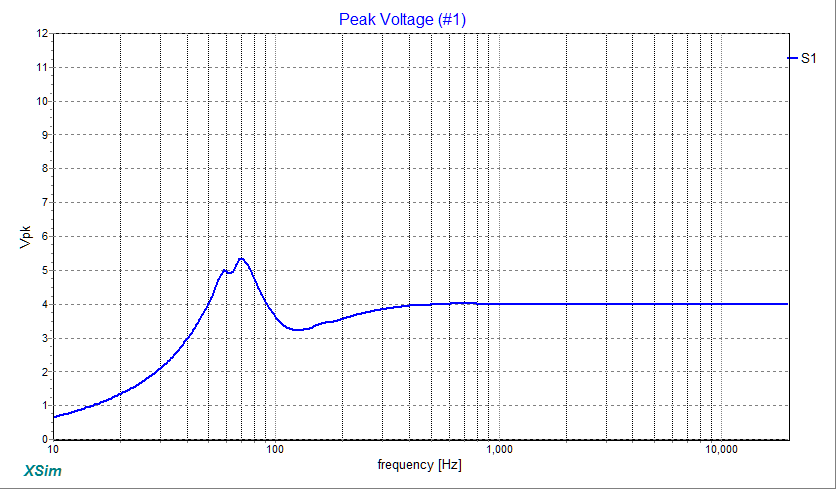
Q of this cabinet is pretty high, but I think with lower Q it would work a little better.
in dB:
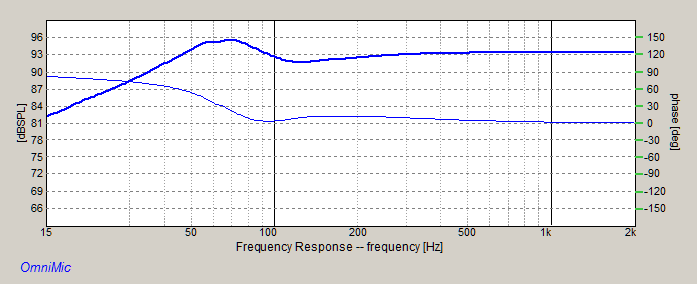
Here is the voltage bump given by a 1000uF series cap into the impedance of a pair of paralleled woofers in a sealed cabinet I have here (resonant peak at 91Hz). Without the cap, it's just 4V across the woofers.
Q of this cabinet is pretty high, but I think with lower Q it would work a little better.
in dB:
Attachments
Last edited:
A cap in series are 6db/oct High pass filter, and can be used to flatten the frequency curve from a High QT woofer in a very small closed cabinet.
450uf should flatten the response from a speaker with a huge peak in the 50-70hz area quite well.
Disadvantages: Except from a tad higher group delay? I don't know.
450uf should flatten the response from a speaker with a huge peak in the 50-70hz area quite well.
Disadvantages: Except from a tad higher group delay? I don't know.
This is the impedance matching the situation for the plots I showed above. You can see how it works -- the impedance just below resonance with the cap (blue trace) is reduced compared to the "without cap" (red trace), which puts more current through the woofer(s) there. Then, a little lower the impedance goes up as the capacitive reactance increases again.
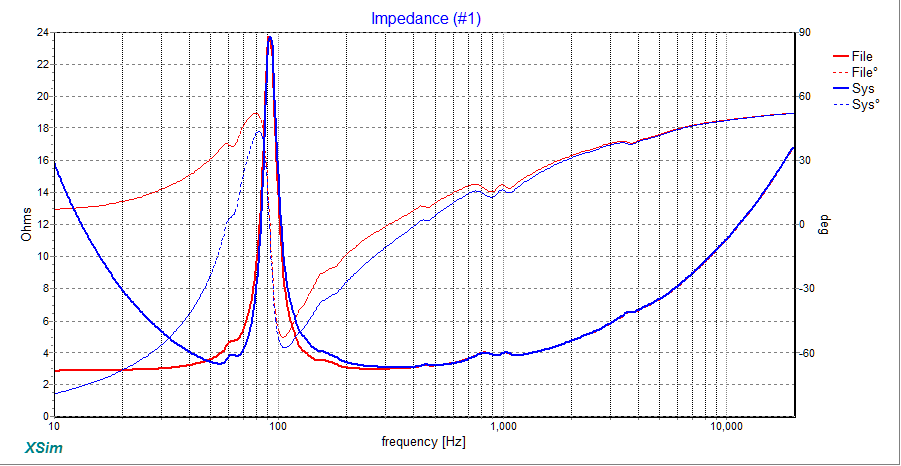
Kind of like a simple passive Linkwitz transform circuit (though lots less versatile).
Kind of like a simple passive Linkwitz transform circuit (though lots less versatile).
Attachments
Last edited:
A main disadvantage is added non linearity. The cap works with the woofer impedance near resonance to create a 3rd order high pass with lower f3 than without the cap. Unfortunately the woofer impedance around resonance varies with drive level so the combined response varies with drive level. This by definition is increased non linearity. The distortion added will depend on the driver. Ive never seen this quantified but it would be interestingI have just got a pair of Mk1 Wharfedale Diamonds to play around with. Hugely successful cheap speaker from the 1980s. One aspect of the design is a 450uF capacitor in series with the main drive unit (which runs full range) (The speaker is rated at 6ohm)
My understanding is that the reason for this is so that a smaller cabinet can be used, and the cap brings down the resonant peak. I believe KEF used this in some of their designs.
This seems a neat trick, but what are the disadvantages?
AES Journal Forum >> Closed-Box Loudspeaker with a Series Capacitor
Similar things are possible with reflex tuning also.
Regards
Charles
Similar things are possible with reflex tuning also.
Regards
Charles
I have seen series caps used in Kef, Wharfdales and Infinity's bass crossover ccts and in a certain canton speaker range (reflex) it was incorporated with a large value parallel inductor to make a high pass bass cct and the implementation was even given a trade marked name.
cheers Arthur.
just found the cct for the canton, the cap was 820uf and the inductor was 23mH
cheers Arthur.
just found the cct for the canton, the cap was 820uf and the inductor was 23mH
The Diamond Mk 1 was developed from the high end TSR102.
The Diamond's 'woofer' was apparently the TSR102's midrange unit and, as such, had to be protected from bass excesses by the series capacitor.
The box was rear ported.
Details of the Diamond Mk 1 can be found here:
Wharfedale Diamond | zStereo
The Diamond's 'woofer' was apparently the TSR102's midrange unit and, as such, had to be protected from bass excesses by the series capacitor.
The box was rear ported.
Details of the Diamond Mk 1 can be found here:
Wharfedale Diamond | zStereo
Another way of extending/boosting bass output from a sealed enclosure using passive components is to use a high value cap and high value inductor in series with the bass driver (crossover< 200~300Hz, as used in 3 or 4 ways ) though the resultant impedance drops below nominal value of bass driver, Infinity used this type of circuit to increase the bottom end extension of some of their speaker designs.
It certainly seems to work. I tried bypassing the large capacitor, (since I thought it was there to protect the driver, and I only play at fairly low volumes.) I was expecting an improvement, but all I got was an appreciable loss of bass, and it all sounded "smaller".
This technique seems to have been used in the past at least by KEF and I wondered why it is not more generally used.
This technique seems to have been used in the past at least by KEF and I wondered why it is not more generally used.
Not generally used because it is a waste of time and money, I would think.
The sim does not lie. The dotted line is the effect of an ideal capacitor:
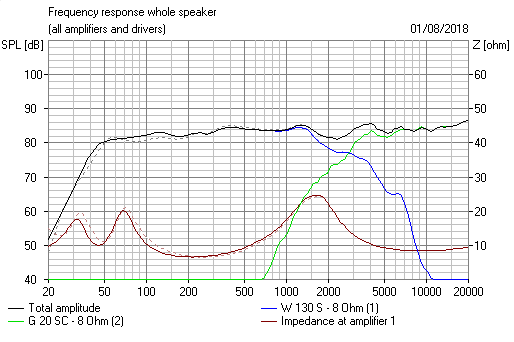
Hardly worth doing, I'd say. Any ESR (resistance) in the capacitor would reduce level too right across the basses output range. Any perceived boosting effects on bass just show how difficult subjective evaluations by memory are.
Wharfedale did this in the 8" plus tweeter Wharfedale Laser 90B too:
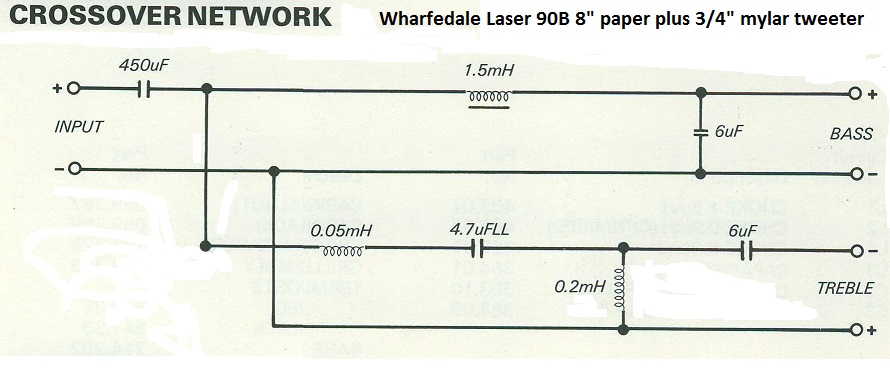
But 90% of the time they didn't. And nobody here does, AFAIK. So I guess someone at Wharfedale was infatuated with the idea. It's possibly worth mentioning that there must be a reduction in the effective damping factor from the amplifier, but the general notion is that good damping factor is essential with reflex.
The sim does not lie. The dotted line is the effect of an ideal capacitor:
Hardly worth doing, I'd say. Any ESR (resistance) in the capacitor would reduce level too right across the basses output range. Any perceived boosting effects on bass just show how difficult subjective evaluations by memory are.
Wharfedale did this in the 8" plus tweeter Wharfedale Laser 90B too:
But 90% of the time they didn't. And nobody here does, AFAIK. So I guess someone at Wharfedale was infatuated with the idea. It's possibly worth mentioning that there must be a reduction in the effective damping factor from the amplifier, but the general notion is that good damping factor is essential with reflex.
Last edited:
Strassacker: Speaker Building, Components
look at the "Subwoofer Tuning Using Cabinet, Capacitor and Resistor" page
http://www.humblehomemadehifi.com/download/Humble Homemade Hifi_Black Box.pdf
look at the "Subwoofer Tuning Using Cabinet, Capacitor and Resistor" page
http://www.humblehomemadehifi.com/download/Humble Homemade Hifi_Black Box.pdf
it is a waste of time and money, I would think.
The sim does not lie.
Rather a case of wrong application and wrong conclusion.

Choose a very small closed box resulting in a Qtc of 1.2. Then the capacitor flattens the resonance peak and extends the frequency response below resonance. That's how it works.
- Home
- Loudspeakers
- Multi-Way
- Disadvantages of Capacitor in series with main driver.
